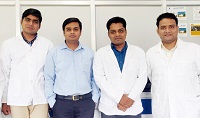Innovation at its peak, IIT-G comes up with a sensor
 S Vishnu Sharmaa, INN/Chennai, @infodeaofficial
S Vishnu Sharmaa, INN/Chennai, @infodeaofficial
Indian Institute of Technology, Guwahati (IIT-G) always has something up its sleeve as far as innovation is concerned. The well known institution has come up with a paper based sensor that can test the freshness of the milk.
Sensor developed by the researchers there works on a simple method. A research team led by Dr. Pranjal Chandra, assistant professor, department of Biosciences and Bioengineering, IIT-G along with Kuldeep Mahato, a research scholar developed a simple visual detection technique to detect the quality of milk, without the need for special equipment and instruments and their work has recently been published in the journal ‘Biosensors and Bioelectronics.’
The quality and freshness of the milk depends on the presence of the microbes in the milk. Their presence not only can affect the taste but also lead to health related complications. Though there are a few methods that can test the freshness of the milk they are time consuming and also involve sophisticated machines and manpower.

The new technique was developed taking these into consideration. Methylene blue test is time consuming, while commercial phenol based tests require advanced spectrometers and involve multi step procedures. One should be in a position to test the milk freshness at any time, said Pranjal.
For this to happen we need instruments that can be easily used. Alkaline Phosphatase (ALP) is a metalloprotein found naturally in raw milk samples and is considered an important biomarker in quality control of milk.
It is found in raw milk and is destroyed during pasteurization. ALP is also found in higher amounts in the case of milk derived from animals with infection in the mammary glands.
Detection of ALP in milk can thus point to inadequate pasteurization and perhaps contamination. Researchers have used simple filter paper, chemically modified it, and loaded it with a recognition element anti-ALP, which captures the ALP present in the milk.
Upon treatment of the colour forming compound BCIP to the captured complex of ALP forms a blue-green coloured precipitate, that otherwise does not gives any colour in the absence of ALP.
The intensity of the colour indicates the amount of ALP present. The team used a smartphone to capture the image of the colour and used the RGB (Red Green Blue) filter in the phone to profile the colour obtained, which could be co-related to the concentration of ALP present in the test sample.
Our sensor takes merely 13 minutes to detect ALP and hence it can be applied for quick onsite analysis, said Dr. Chandra. The researchers successfully tested milk obtained from villages and commercially available milk samples using their paper-based sensor kit, and found that they could detect down to 0.87 units of ALP per millilitre of milk to about 91–100% accuracy.
This detection limit and accuracy make it possible to discriminate raw milk (often contains as high as 191 U/mL ALP) from pasteurized/boiled milk which contains ALP in ultra-trace amount.
Based on the detection principle, the team has also developed a miniaturized detection kit and demonstrated the instrument-free, in-kitchen applicability of the kit for milk monitoring.
‘We plan to extend the sensing principle we have developed for ALP towards the detection of various molecules in different matrices. In fact, we have developed another sensor for ALP detection using a label-free bio-electronic chip.
This new sensor has been developed by Kuldeep Mahato, Ashutosh Kumar, Mr. Buddhadev Purohit. The developed bio-electronic chip is an advanced version of the paper-based kit with improved accuracy, said Chandra. ‘We have plans to commercialize both the variants of milk pasteurization testing kits.’




